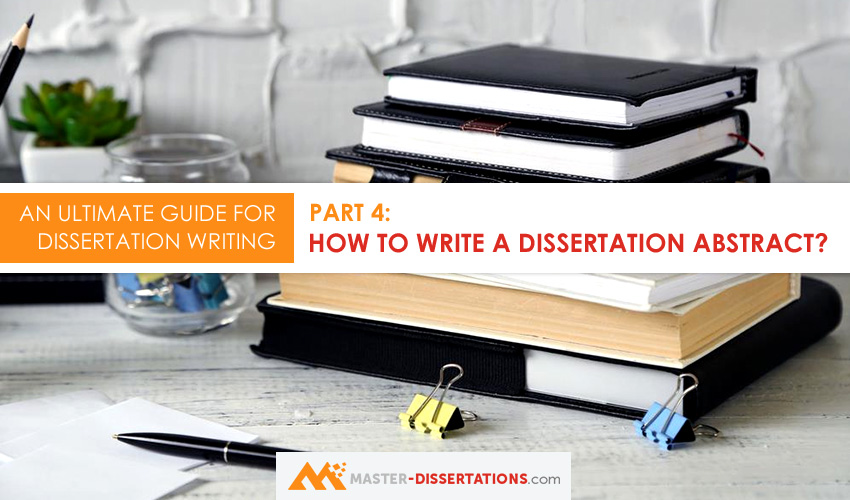
An effective way of preparing to write an abstract is to read back over any journal article abstracts or abstracts from any other texts you used in the literature review stage of your project or referred to as secondary source materials. While you are re-reading these, ask yourself these questions:
- What aspect of this article or text do you think compels you to read it in its entirety?
- How does this article or text tell you that its content is relevant to your particular study and to the topic you are researching?
Then, once this is done, you should think about the following questions when you are planning the abstract for your paper:
- Why would anyone want to read this particular dissertation?
- How is it relevant i.e. in what way?
- Will this dissertation help other people with their own research and how?
- What key terms and concepts are used in this dissertation?
- What are the questions it answers?
When this has been done, you should attempt to draft an (approximate) 50-word summary that addresses each one of the five previous questions. Then you can polish these sections and add an introduction and a conclusion i.e. add a “top and tail” to it. The resulting text should amount to an effective abstract that describes the focus, purpose, and relevance of your entire dissertation.
There are two forms that a dissertation abstract can typically follow:
- Descriptive abstracts
This type of abstract lets readers to know what type of information is contained in the article, paper, or report. It also states the purpose, scope, and methods used. However, descriptive abstracts do not include any results, recommendations, or conclusions and they are not usually as long as informative-type abstracts. In fact, they do not normally exceed 100 or so words. The purpose is purely to introduce readers to the subject matter, and it is then up to readers to read the entire text to learn about the writer’s results, recommendations, and conclusions.
- Informative abstracts
Abstracts of the informative type set out specific details or information from a dissertation. This information usually includes the paper’s purpose, scope, and the methods used. Additionally, unlike descriptive abstracts, this type discusses the results i.e. what the writer found out, their recommendations, and their conclusions. While this type is also relatively short, it is longer than the descriptive-type abstract and can vary from one paragraph to one or two pages, with much dependent on how much of the entire paper needs to be abstracted. Either way, informative abstracts comprise of up to 10% of the entire paper. They enable readers to determine if they should (or want to) read the whole text.
What Are the Ingredients of a Great Abstract?
Often, an abstract is required when a paper is to be added to a journal-style database. Therefore, you should consider choosing keywords that will allow your paper to be easily found by those who want to retrieve it using electronic methods. Both titles and the actual abstracts themselves are filed in electronic form, and keywords that make them retrievable are also stored in an associated electronic system. Hence, when someone starts searching for specific information on a topic, they type in keywords that relate to this topic or subject, and they receive a computer printout of titles of papers, reports, articles and various other types of documents that contain these particular keywords.
The best abstracts are comprised of one or a few concise, coherent, well-developed, and unified paragraphs that are capable of standing alone. The structure will follow the introduction, main body, and concluding format in which the purpose of the dissertation, the results, recommendations and conclusion(s) will be presented in this particular order. The abstract will strictly follow the dissertation’s chronology while logical transitions (or connections) should be made between the different sections or blocks of information. A successful abstract will not present any fresh information (i.e. information that is not already in the dissertation) but merely summarize it. Readers (of many different backgrounds) should easily be able to understand it.
Whatever definition has been agreed, Master-Dissertations.com has created this website to assist you with the writing of your final university paper. The aim of our site is to advise you on how best to write long papers while ensuring these are fully referenced, properly cited and well-organized.
Moreover, you can check an example of the dissertation abstract (this is the part of the “What challenges are faced by consumers of online banking?” dissertation. You can find other parts of this paper reading our blog).
Dissertation Abstract Example
Technology revolution and financial liberalization have created room for the new development towards efficient delivery of banking services. There is so intense competition in the banking industry from other banks and financial intermediaries. Other alternative financial services also pose a lot of competition to the banks. Another major challenge for banks is the growing needs and expectations of consumers. Consumers have become more discerning and more involved in financial decisions. This study investigates the challenges online banking consumers face in the modern world. It also indicates concerns regarding the privacy and security of online banking in the country. Secondary data was collected from scholarly articles and books while primary data was collected by administering structured questionnaires to 200 respondents and conducting interviews with key stakeholders in the banking industry.
| How to create a dissertation title? | How to Create an Appendix for a Dissertation |




